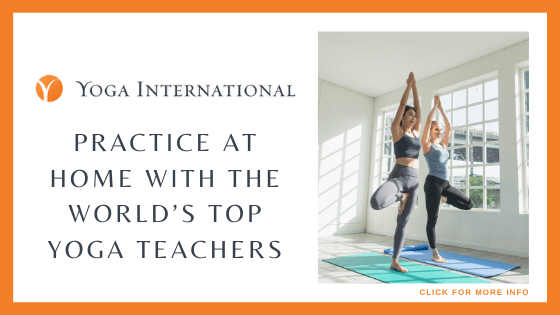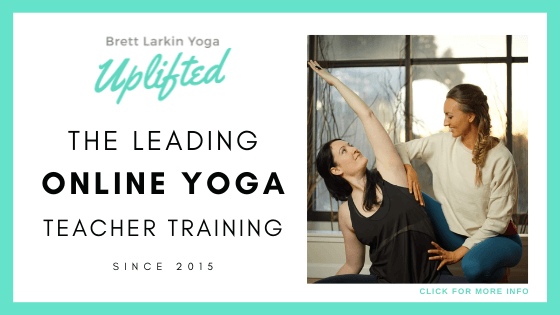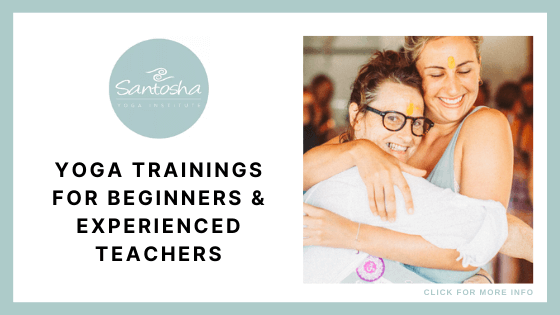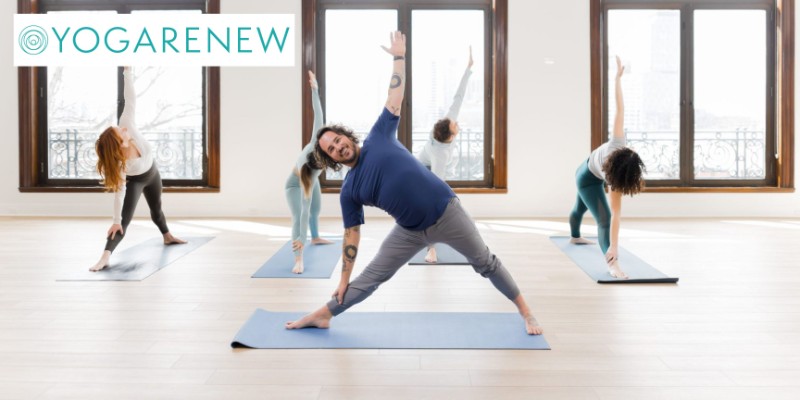
s people around the world continue to embrace practices that promote good physical and mental health as well as general well-being, yoga has never been more popular. And in the digital age that we live in, yoga has never been so accessible. There are a number of online resources for practitioners of all levels, including websites that are completely devoted to the art and practice of yoga.
The 5 Best Yoga Websites that are one-stop shops, offering a full range of resources are:
Whether you envision a career in yoga and need to find the best instructor certification courses or simply need help getting the hang of the lotus position, yoga websites are your best resource. But navigating through the hundreds of online sites that are out there can be a daunting task. We’ve done the hard work for you, so read on for the five best websites for all things yoga.
Article Topics
The Shift to Yoga Online
The term yoga comes from the ancient Sanskrit (one of the oldest languages in the world and the precursor to Indian languages) word Yuj, which refers to the union formed between practitioners and cosmic consciousness. The concept of yoga goes back approximately 5,000 years ago, and its core branches were identified by Maharishi Patanjali in a collection of writings (known as sutras) as follows:
- Yama: social ethics
- Niyama: personal ethics
- Asana: postures
- Pranayama: life force
- Pratyahara: inner reflection
- Dharana: intense focus
- Dhyana: meditation
- Samadhi: becoming one with the self
Yoga began to spread west from India in earnest in the late 19th century, and it was not until the 1980s that it became popular in westernized societies. From its ancient beginnings to the modern era, yoga has not only withstood the test of time, but it has also evolved from a once sacred artform combining physical and mental disciplines of well-being to a mainstream form of exercise and popular vehicle for practicing mindfulness.
How popular is yoga today? The numbers speak for themselves:
- In 2018, an estimated 75 million people in the U.S. practiced yoga
- That number was estimated to climb to over 55 million within a few years (by 2020)
- Yoga is estimated to be a $12 billion dollar industry
Where once yoga was taught and learned exclusively in specialized settings like studios and retreats, practitioners ranging from beginners to experts can now learn the basics or master advanced techniques through digital resources like online video libraries and live streaming services. In a similar fashion, people who want to make a career out of teaching others the art of yoga can now become certified instructors by taking online courses.
While learning yoga virtually could never replicate the experience of working with a live instructor, particularly in a small group or one-on-one setting, there are significant benefits to using digital resources to learn yoga, such as:
- The level of accessibility that online or virtual yoga instruction affords to practitioners is beyond dispute – as long as you can access and view content, you can practice yoga from anywhere
- Live-streamed yoga sessions, even those involving groups of students, are of the most benefit to home practitioners as they allow interaction with instructors and provide opportunities for personalized guidance
- Studies have shown that even when practiced virtually, online-based yoga provides benefits for the body and mind of practitioners who maintain a regular schedule set aside for yoga
As far as yoga in the digital space is concerned, a recent survey shows that of the millions of people in the U.S. that participate in yoga, nearly a quarter of them do so from the comfort of their home by utilizing some form of digital content through any number of compatible devices.
Yoga Comes in Many Shapes and Forms
The term yoga, as it is used today, refers not to just one practice rooted in well-being but rather an entire family of interrelated disciplines. There are a number of different styles of yoga being practiced around the world, each offering a distinct approach to enhancing the physical and mental health of its practitioners. Here is a look at the most popular forms of yoga among yogis and yoginis everywhere:
- Anusara: this is a new form of yoga that was developed in the U.S. in the 1990s, and it encourages practitioners to find and expose their inner goodness through rigorous physical practices
- Ashtanga: with roots that can be traced back to ancient yoga concepts, Ashtanga is a highly technical style of yoga that emphasizes poses performed in specific sequences and tied to corresponding breathing techniques
- Bikram (Hot Yoga): of all the styles of yoga that are practiced today, Bikram is one of the most popular and well-known, most famously for the way that classes are conducted in heated rooms so as to induce heavy perspiration by its practitioners (due to disputes related to trademarked poses, many studios refer to their discipline as hot yoga rather than Bikram)
- Hatha: this is the catch-all style of yoga that ranks as the most widely practiced form of yoga in western societies and is popular among beginners and casual yogis for its moderate skill level and less strenuous movements
- Iyengar: the primary focus of this style of yoga is achieving proper body positioning and alignment aids like blocks, chairs, blankets, and even straps are commonly used by practitioners
- Restorative: often referred to as yin yoga, this is one of the least strenuous forms of yoga practiced today with its emphasis on muted and subdued movements and its calming effects on those who practice it
- Vinyasa: with its flowing sequences of carefully orchestrated movements, Vinyasa (Sanskrit for “to place in a special way”) is moderately demanding as there are numerous transitions from one pose to the next, but it is also one of the more popular forms of yoga
So fluid and dynamic is the art of yoga that there is an undefined number of different styles, and new variations are constantly emerging. Aside from the styles described above, there are specialized types of yoga that have smaller but equally enthusiastic followings.
These include:
- Kundalini: this style of yoga emphasizes physical movements and stimulation of neural centers throughout the body and incorporates deep meditation and chanting into its practices
- Aerial: the name of the game in aerial yoga is inversion (i.e., being upside down), and it relies on apparatus like suspended slings and hammocks to facilitate practitioners striking poses upside down in order to partake in benefits ranging from decompression of the spine, oxygenation of the brain, and redistribution of facial fluids (for its anti-aging properties)
- Prenatal: the smooth, passive movements of prenatal yoga combined with its emphasis on breathing techniques make it an ideal activity for pregnant women
With so many different styles of yoga to choose from, practitioners can pick and choose the ideal form that best suits their particular needs. This diversity in yoga practice is also appealing to those who seek to take their interest in yoga to a higher level – by becoming a yoga instructor.
What is Yoga Certification?
Regardless of the particular style or discipline, yoga involves specific poses, movements, and breathing exercises. As such, proper instruction is vital not only for practitioners to learn proper yoga techniques but to ensure their safety as well (i.e., to avoid bodily injury). To this end, yoga instructors are subject to stringent certification processes.
These are the most common yoga instructor certifications issued by the Yoga Alliance, the largest nonprofit organization serving the yoga community:
- RYT 200: this designation (RYT – Registered Yoga Teacher) certifies that the instructor has completed 200 hours of approved training courses
- RYT 500: this certifies that an RYT has completed 500 hours of training and has subsequently logged a minimum of 100 hours of live teaching
- E-RYT 200: an E-RYT (Experienced Registered Yoga Teacher) 200 instructor must complete 200 hours of teacher training and log 1,000 hours of live teaching (which must encompass two years following completion of the teacher training)
- E-RYT 500: this is the highest level of certification offered by the Yoga Alliance and requires 500 hours of teacher training and four years and 2,000 hours of teaching experience
Yoga instructor certification is a demanding process that requires a passion for yoga and a willingness to commit the time and energy required to fulfill its stringent requirements. But like yoga itself, it is not only the destination that drives the pursuit but the journey as well.
Which Website is Best for Yoga?
Yoga websites can be a yoga practitioner’s best resource for all things yoga, regardless of skill level or experience. As an all-around resource, Online Yoga Planet offers the best combination of:
- Digital content
- Courses for prospective instructors
- Pertinent reviews for practitioners of any style of yoga
It even provides a useful guide for aspiring yoga influencers looking to promote their personal brand.
The 5 Best Websites for All Things Yoga
With the number of yoga sites on the internet proliferating by the day, finding the right website for your yoga needs can be a daunting task, but these five websites are a good place to start.
1. Online Yoga Planet
Online Yoga Planet is a one-stop shop for all things yoga regardless of where your particular yoga-related interests lie. Starting with yoga practitioners, these are some of the highlights of this feature-packed website:
- In-depth evaluations of online yoga classes for practitioners of all skill levels and instructional programs for those interested in pursuing a career in yoga instruction
- Informative articles that are written about a wide range of yoga-related topics, including detailed studies on fundamental yoga poses
- Straightforward reviews of yoga gear, including clothing, mats, and other accessories
For prospective yoga instructors, Online Yoga Planet is an invaluable resource for finding 200, 300, and 500-hour RYT courses as well as CE certification programs.
2. My Vinyasa Practice
With prospective yoga teachers in mind, My Vinyasa Practice is a thoughtfully designed website offering 200, 300, and 500-hour yoga teacher training (YTT) courses for people looking to take their passion for yoga to the next level.
As a registered online yoga training school with the Yoga Alliance, My Vinyasa Practice takes a no-frills approach toward providing a straightforward curriculum that allows students to learn at their own pace but with easily accessible support from instructors and peers.
My Vinyasa Practice also offers a number of highly specialized yoga courses, including:
- Mindfulness and meditation
- Entrepreneurship
- Yoga therapy for grief, depression, and anxiety
Whether the goal is to operate a full-fledged studio or lead a local community class, My Vinyasa Practice can be an instrumental part of a yoga instructor’s path to success.
3. Brett Larkin
If there is one theme running throughout the Brett Larkin Yoga Uplifted website, it is empowerment. It not only contains an extensive catalog of digital content to train yoga enthusiasts to become certified yoga instructors, but it also offers a wealth of resources to educate and encourage new yoga teachers to become successful entrepreneurs with flourishing yoga practices, whether they be online or in-studio.
These are just a few of the features of this popular website:
- 200, 300, and 500-hour yoga teacher training courses in the disciplines of hatha, vinyasa, and kundalini
- Dedicated prenatal yoga program, including teacher certification
- Business courses emphasizing proven strategies and techniques for operating a successful and profitable yoga enterprise
Aside from the teacher courses, the Brett Larkin site also contains an enormous library of digital content. Brett Larkin is also a prolific content producer on YouTube, with her yoga channel claiming over 440,000 subscribers and an astonishing 34,000,000 views and counting.
4. Santosha Yoga Institute
As far as the breadth and scope of yoga teacher training courses, the Santosha Yoga Institute has few peers, and its website is as comprehensive of a YTT online resource as you can find on the internet. The Santosha Yoga Institute is a certified yoga school by the Yoga Alliance and accredited to provide teacher trainings for 150, 200, 300, and 500-hour requirements.
As far as instructor certifications, there are a number of options available, including:
- RYT-200
- 50-hour yoga therapy teacher training
- 50-hour yin yoga teacher training
Students can choose to enroll in a number of online-only teacher training courses (fully accredited) that allow for self-paced completion, or for those who are prepared to fully immerse themselves in a transformative journey, Santosha Yoga Institute also offers on-site instruction in its training facilities located in Bali, Indonesia and Byron Bay, Australia.
5. Yoga International
Geared toward yoga practitioners who are constantly on the go, Yoga International is a yoga website that operates on a membership model much in the way that people pay monthly gym membership dues. Depending on the membership level, these are some of the benefits that are offered:
- An extensive digital catalog of on-demand instructional videos and courses
- In-depth articles and podcasts
- Participation in live-streamed classes and workshops
- Live Q&A sessions with instructors
- One-on-one training sessions with 500-hour certified instructors
Yoga disciplines featured on Yoga International’s website include:
- Hatha
- Vinyasa
- Restorative
- Prenatal
Aside from professionally produced video materials, this site also offers valuable guidance relating to nutrition, meditation, and lifestyle topics.

Conclusion
No matter what the style or form, yoga can be viewed as a journey that transforms the body and elevates the mind. And for those seeking to improve their yoga skills or become certified to teach others, online resources like the five yoga websites we have reviewed in this article are the best way to get started on the right path.






